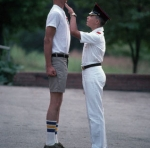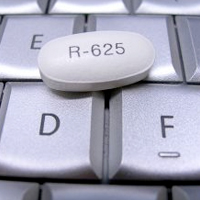
Good Posture
One of the problems of trying to achieve ‘good posture’, or ‘perfect posture’ or “proper posture” or even “correct posture” is that these terms imply rigidity. Some Alexander Technique teachers attempt to avoid the word posture altogether, calling it the ‘P’ word.
One could learn to have ‘proper posture’ in a few minutes, especially if you think of military posture. Military posture is standing up as straight as possible, with your stomach in, chest out, chin tucked in, shoulders back etc. I guess we could add ‘not being able to move’ and ‘not being able to breath fully’. ‘Tighten every muscle in your body and tense your jaw.’ Might as well make a fist, too. Do we really need any more tension?
Alexander Technique Posture and Poise
Maybe we could think of ‘poise’ instead of ‘posture’. What if you think of poise as being flexible, being able to change direction seamlessly and easily? Poise and pride. Think of having pride in yourself, having your head up high, but without arrogance. You don’t want to think of sticking your nose in the air. In fact, sometimes you’ll want to lower your nose, as the crown of your head moves up.
Alexander Technique for Better Posture
Poise, pride, freedom of movement, ease and lightness may describe what the Alexander Technique offers in terms of good posture or proper posture. However, when people come for sessions for ‘posture correction’, their posture gets fixed. One of the differences between good posture and using the Alexander Technique is that with the Alexander Method we’re subtracting tension instead of adding it, and it’s permanent. Plus, the Alexander Technique has extremely beneficial side effects.
Mark Josefsberg Alexander Technique NYC
Receive Free Alexander Technique Tips:
[contact-form-7 404 "Not Found"]
Please leave comment below.











[…] of your lower back in an attempt to ’sit up straight’, which is just another version of bad posture. Think about your spine lengthening up and down, and let your breathing be slower, and fuller. If […]
[…] or neck pain. I think John Sarno would agree that the solution is not to sit up rigidly straight in military posture, shoulders back, chest out, stomach in, chin back […]
[…] Most people slump in front of the computer. Typical computer posture includes poking one’s neck towards the screen, which can compress the spine from top to bottom. By learning, through Alexander Technique lessons, how to release tension in your neck, your head will naturally move upwards, towards the ceiling. Let your head take your spine up as well. The exaggerated curves of your spine will be less so. You won’t be collapsed, and your shoulders will sit further back on your previously-collapsed ribcage without you having to ‘push your shoulders back’, military style. […]
Good explanation.
The word ‘posture’ alone may becomes doing.
But,
i think the ‘alexander postural directions’ leads to poise and direction and movement.
What you think?
Thanks Geetha,
I think it all becomes doing, we just want the right kind of doing. I also think it depends upon who you’re talking with. If the word posture makes someone sit up rigidly straight, well we don’t want that. What we want people to ‘do’ with the Alexander Technique is to become aware, wait or pause, and then direct. the word posture can get people through the door, which is the first step, I think.
What you are saying is true,
but i think-
‘back lengthen and widen’- POSTURE
‘back goes back and up’- DIRECTION
then we can say,
” the back lengthens and widens(posture)
and goes
back and up(direction)”
in the above statement the posture is clearly following the direction.
So,
i think posture,direction are part and parcel of the alexander technique.
Deviding them separate, not makes the sense.
So,
” LET THEM CALL ‘ALEXANDER POSTURAL DIRECTIONS’ ”
am i correct?
Hi Geetha,
I’m not sure ‘back lengthen and widen’ is posture. I think that’s an Alexander Technique direction.
I wish to free my neck so that,
my torso can lengthen and widen.
That’s the very beginning of Alexander’s primary directions.
[…] Correct sitting posture should feel comfortable, or you won’t be able to maintain it. Correct sitting posture is not slouching, nor is it sitting in military posture. […]
This is WONDERFUL, Mark. I love the elegance & simplicity of what you’ve offered us. Poise, flexibility, a new experiencing of pride. Great!!! Thx.
Thank you Lynn!
People definitely confuse the Alexander Technique with military posture, but nothing can be further from the truth. I’m not sure about the elegant part, but I’m definitely simple!